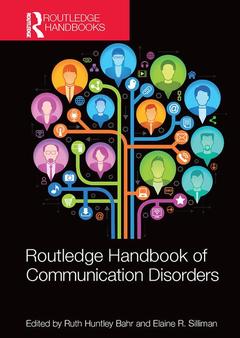Routledge Handbook of Communication Disorders
Coordonnateurs : Bahr Ruth H., Silliman Elaine R.

The Routledge Handbook of Communication Disorders provides an update on key issues and research in the clinical application of the speech, language and hearing sciences in both children and adults.
Focusing on areas of cutting-edge research, this handbook showcases what we know about communication disorders, and their assessment and treatment. It emphasizes the application of theory to clinical practice throughout, and is arranged by the four key bases of communication impairments:
- Neural/Genetic Bases
- Perceptual-Motor Bases
- Cognitive-Linguistic Bases
- Socio-Cultural Bases.
The handbookends with an integrative section, which looks at innovative ways of working across domains to arrive at novel assessment and treatment ideas. It is an important reference work for researchers, students and practitioners working in communication science and speech and language therapy.
General Introduction Part 1: Genetic, Neurobiological, and Neurophysiological Systems of Communication Impairments 1. (A)typical Language Development: Genetic and Environmental Influences 2. Neural Network Mechanisms and Adult Language 3. Reading Impairment: From Behavior to Brain4. Brain Imaging Studies of Developmental Stuttering: A Review5. Speech and Language Disorders in Children with Craniofacial Malformations6. Neurophysiology and Voice Production7. Neural Control of Swallowing and Treatment of Motor Impairments in Dysphagia8. Neuropharmacologic Approaches to Aphasia RehabilitationPart 2: Perceptual-Motor Systems of Communication Impairments 9. Oral Sensorimotor Development: Research and Treatment10. Perceptual Processing of Speech in Infancy11. Developmental Models of Childhood Apraxia of Speech12. Speech Recognition Skills of Children with Cochlear Implants13. Instrumental Analysis of Atypical Speech14. Contemporary Issues in DysarthiaPart 3: Cognitive and Linguistic-Discourse Systems of Communication Impairments 15. What Bilingualism Tells us About Phonological Acquisition16. Information Processing in Children with Specific Language Impairment17. Spelling Strategies and Word Formation Processes: Evidence from Developmental and Spelling Ability Data18. Literacy Development: The Interdependent Roles of Oral Language and reading Comprehension19. Child Word Finding: Differential Diagnosis Guides Comprehensive Intervention20. Person Behind the Written Language Learning Disability21. Vocabulary and Grammatical Profiles and Relevant Interventions for Adolescents with Down Syndrome22. Beyond the Theory of Mind Hypothesis: Using a Causal Model to Understand the Nature and Treatment of Multiple Deficits in Autism Spectrum Disorder23. Language and the Speaking Mind: Brain in Stuttering24. Linguistic Disruption in Primary Progressive Aphasia, Frontotemporal Degeneration, and Alzheimer's Disease 25.Word Retrieval Impairment in Adult AphasiaPart 4: Social Interactional Systems of Communication Impairments 26. Two Challenges of the Academic Language Register for Students with Language Learning Disabilities27. African American Children's Early Language and Literacy Learning in the Context of Spoken Dialect Variation28. Treatment Approaches for Second Language Learners with Primary Language Impairment29. Second Language-literacy Learning and Social Identity: A Focus on Writing30. Continuities in the Development of Social Communication: Triadic Interactions and Language Development in Children with Autism Spectrum Disorder31. Emotional Intelligence and Treatment Outcomes in Children with Language Impairment32. Social Participation and Aphasia33. Bilingualism and AphasiaPart 5: Reaching Towards Systems Interdependence 34. Interaction of Motor and Language Factors in the Development of Speech Production35. Neuro/Cognitive and Sociocultural Perspectives on Language and Literacy Disabilities: Moving from Parallel Play to Productive Cooperation36. Communication as Distributed Cognition: Novel Theoretical and Methodological to Disruptions in Social Communication Following Acquired Brain Injury
Ruth Huntley Bahr is Professor of Communication Sciences and Disorders with a Courtesy appointment in Psychology at the University of South Florida, USA. She is a Fellow of the American Speech-Language-Hearing Association (ASHA), a Fellow of the International Society of Phonetic Sciences (ISPhS), and was awarded the Svend Smith Award for Practical Applications of Phonetics. Her areas of specialization include clinical phonology, voice production, dialectal variations, and prosody. Recent research involves the spelling abilities of typically developing children and dialectal/second language influences on literacy. She is currently serving as the President of ISPhS and Executive Secretary of the International Association of Forensic Phonetics and Acoustics and was past Editor of Language, Speech, and Hearing Services in Schools.
Elaine R. Silliman is Professor Emeritus of Communication Sciences and Disorders and Courtesy Professor of Psychology at the University of South Florida, a Fellow of the American Speech-Language-Hearing Association (ASHA), a recipient of the ASHA Honors for her significant scholarly contributions, and a Fellow of the International Association of Research on Learning Disabilities. Her research interests and publications focus on academic language proficiency in children and adolescents who are struggling with reading, writing, and spelling, including monolingual English-speaking children with social dialect variations and bilingual (Spanish-English) children. She is the author or co-author of numerous journal articles and chapters, and a co-editor of eight books, including the Routledge Handbook of Communication Disorders.
Date de parution : 06-2017
17.4x24.6 cm
Disponible chez l'éditeur (délai d'approvisionnement : 14 jours).
Prix indicatif 50,12 €
Ajouter au panierDate de parution : 05-2015
17.4x24.6 cm
Disponible chez l'éditeur (délai d'approvisionnement : 14 jours).
Prix indicatif 256,94 €
Ajouter au panierThèmes de Routledge Handbook of Communication Disorders :
Mots-clés :
speech and language therapy; speech and language pathology; communication science; communication disorders; Communication disorders research; ruth bahr; elaine silliman; Speech Language Pathologists; Left IFG; Attention Defi Cit Hyperactivity Disorder; American Psychiatric Association; Central Pattern Generator; SSD; Hard Palate; Acquired Brain Injury; Disfl Uency; Speech Language Therapy; CNS Structure; Vocal Fold; Distributed Cognition Framework; Bilingual Aphasia; Narrative Language Samples; Developmental Stuttering; Pre-stroke Levels; Social Communication Problems; Round Window; Gaze Cues; ERP Response; De Diego Balaguer; TDCS; ToM Task; TASIT


